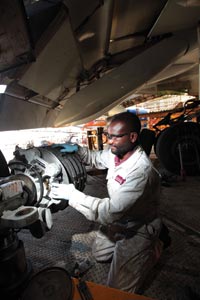If anybody understands the complexities of operating large airliners, it is Garry Copeland. As director of engineering at British Airways Engineering, he has got one of the world’s major Boeing 747 fleets to look after for another 15 years or so. From 2013, he will be servicing the Airbus A380 – by the end of this year modifications to one of BA’s London Heathrow hangars will be under way, to accommodate the height of the double-decker’s tail – and with the Boeing 787 set to join BA’s fleet in 2012, Copeland is just a couple months away from kicking off formal training for the instructors who will teach his team to maintain the carbonfibre widebody.
Copeland’s Heathrow components engineering operation does everything from servicing 40,000 aircraft wheels annually to overhauling complex parts such as control surface hydraulic actuators (at the rate of 34,000 components of all types yearly), rebuilding flaps and leading edges damaged by debris and effectively manufacturing critical machined parts such as engine mountings.
Capabilities go way beyond what we might think of as traditional aircraft engineering. In 2008, says Copeland, BA Engineering for the first time spent more hours working on cabin equipment than on airframes.
EXPERTISE
|
|---|
So, it is no surprise that BA Engineering is pushing to capitalise on its London Heathrow and Cardiff capabilities by selling its services to other airlines.
Driving for third-party work makes business sense. As Copeland puts it, the cost of overhauling, say, a fuel pump actuator is about 30% labour and 70% parts, so expertise and efficiency pay and London labour rates are not a reason to have the work done in a cheaper market.
In addition, BA Engineering’s push for third-party business is a strategic move to keep the volume of work high enough to justify maintaining the staff and experience levels, and capital investment, needed to operate efficiently in London.
About 10% of BA Engineering’s workload is for non-BA customers, says Copeland, and he hopes to double that proportion. In revenue terms, the third-party business has gone from £30 million ($47 million) a year 18 months ago to £42-43 million today, so growth is on track to reach £60 million or so in another 18 months. “That’s a creditable effort in the worst recession in recent years,” he says.
BA had tried and failed in the mid-1990s to ramp up its third-party business. But there is no reason why a renewed focus on outside work should not succeed this time, reckons AeroStrategy management consultancy partner David Stewart. He agrees that its Heathrow location is an advantage for BA in line maintenance and component work, and development of a substantial third-party business could lead BA to considering spinning its engineering arm off as an independent business, as Lufthansa and Singapore Airlines have.
“They have the scale and they have the capability to make a go of it,” he says.
Source: Aon News
























